The construction of the Hagia Sophia is a story of a grand vision realized through the genius of its creators, Emperor Justinian I and his chosen architects Anthemius of Tralles and Isidore of Miletus.
The Birth of a Vision: Emperor Justinian I
The man who commissioned the building of the Hagia Sophia we know today was Emperor Justinian I. Justinian came to power in 527 AD, and his reign was marked by ambitious architectural projects that aimed to restore the Roman Empire to its former glory. The Hagia Sophia was to be the crown jewel among these.

The project was born out of disaster. In 532 AD, during the violent Nika Riots, the previous church on the site was destroyed. Justinian seized this opportunity to construct a new, grander church that would symbolize his powerful reign and stand as a monument of Orthodox Christianity.
Masterminds of Design: Anthemius and Isidore
To realize his vision, Justinian appointed two prominent scholars of the time, Anthemius of Tralles and Isidore of Miletus. Anthemius was a renowned mathematician and physicist, while Isidore was a famous professor of architecture and engineering. Their combined knowledge and skills were instrumental in the creation of Hagia Sophia’s unique and innovative design.
Construction and Architectural Feats
The construction of the Hagia Sophia began in 532 AD and was completed remarkably quickly for its time, in just five years, ten months, and four days. Thousands of laborers and artisans were employed, working tirelessly to erect this architectural marvel.
The most striking feature of the Hagia Sophia is its massive dome, which measures 31 meters in diameter and sits at a height of 55.6 meters. The architects employed a series of pendentives – a revolutionary technique at the time – that allowed the circular dome to be placed atop a square base. This resulted in a spacious, luminous central nave flooded with light from the forty windows around the dome’s base.
The grandeur didn’t stop at structural prowess. The interior was decorated with intricate mosaics of gold, silver, glass, and terracotta, depicting Christian motifs and figures, underlining the building’s religious significance.
Evolution Through Time

Over the centuries, Hagia Sophia has withstood natural disasters, including several earthquakes that led to partial collapses of the dome. Each time, the structure was meticulously restored, most notably by the nephew of the original architect, Isidore the Younger.
The building’s function has evolved in line with the region’s changing political and religious landscape. Originally an Orthodox cathedral, it was converted into a Roman Catholic church in 1204 during the Fourth Crusade. In 1453, when Constantinople was conquered by the Ottoman Turks, it was converted into a mosque, and Islamic architectural features, such as minarets, a mihrab, and a minbar, were added without disturbing the existing Christian mosaics. In 1935, it was secularized and turned into a museum, and most recently in 2020, it was reinstated as a mosque.
Conclusion
The creation of the Hagia Sophia was a momentous event in architectural history. Born from the ambitious vision of Emperor Justinian I and brought to life by the exceptional skill of Anthemius of Tralles and Isidore of Miletus, the Hagia Sophia is not just a building, but a symbol of Istanbul’s layered history and cultural diversity.

